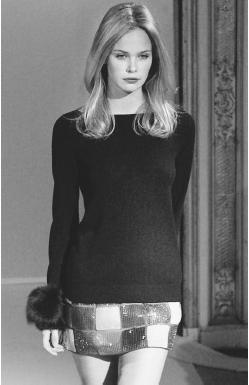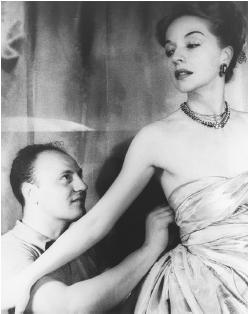Pierre Balmain - Fashion Designer Encyclopedia
French designer
Born: Saint-Jean-de-Maurienne, Savoie, 18 May 1914. Education: Studied architecture, École Nationale Supérieure des Beaux-Arts, Paris, 1933-34. Military Service: French Air Force, 1936-38, French Army Pioneer Corps, 1939-40. Career: Freelance sketch artist for Robert Piguet, Paris, 1934; assistant designer, Molyneux, Paris, 1934-38; designer, Lucien Lelong, Paris, 1939, 1941-45; founder/director, Maison Balmain, Paris, 1945-1982, Balmain Fashions, New York, 1951-55, Balmain Fashions, Caracas, 1954; director, Balmain S.A., Paris, 1977-82; ready-to-wear line launched, 1982; fragrances include Vent Vert, 1945, Jolie Madame, 1953, Miss Balmain, 1967, and Ivoire, 1980; fragrance business purchased by Revlon, 1960; also designed for the stage and films, from 1950. Company continued on

Publications
By BALMAIN:
Books
My Years and Seasons, London, 1964.
On BALMAIN:
Books
Latour, Anny, Kings of Fashion, London, 1958.
Lynam, Ruth, ed., Paris Fashion: The Great Designers and Their Creations, London, 1972.

Milbank, Caroline Rennolds, Couture: The Great Designers, New York, 1985.
Musée de la Mode et du Costume, Pierre Balmain: 40 années de création, Paris, 1985.
Maeder, Edward, et al, Hollywood and History: Costume Design in Film, New York, 1987.
Guillen, Pierre-Yves, and Jacqueline Claude, The Golden Thimble: French Haute Couture, Paris, 1990.
Stegemeyer, Anne, Who's Who in Fashion, Third Edition, New York, 1996.
Articles
Verdier, Rosy, "Balmain: le décor total," in L'Officiel (Paris), April 1985.
"Le point sur les collections: Pierre Balmain," in L'Officiel (Paris), March 1986.
Janssen, Brigid, "A Fashionable Canadian Connection: Pierre Balmain's New Ownership," in Maclean's, 16 November 1987.
Duffy, Martha, "Mais oui! Oscar," in Time, 8 February 1993.
Bowles, Hamish, "Well Suited: Balmain Collection by Oscar de laRenta," in Vogue, May 1993.
Moukheiber, Zina, "The Face Behind the Perfume: Eric Fayer, Owner of Pierre Balmain," in Forbes, 27 September 1993.
***
French couturier Pierre Balmain believed "dressmaking is the architecture of movement." His mission, as he saw it, was to beautify the world like an architect, and the relationship between architecture and couture was emphasized throughout Balmain's career. He initially studied to be an architect, yet the beauty of couture, Balmain often argued, was when it was brought to life on the human form. He also believed "nothing is more important in a dress than its construction."
The House of Balmain opened, with great acclaim from the fashion press, in 1945. Alice B. Toklas wrote, "A dress is to once more become a thing of beauty, to express elegance and grace." Prior to opening his own house, Balmain apprenticed with couturier Edward Molyneux, in Paris, for five years. These years with Molyneux taught him about the business of couture, as Molyneux was at the height of his success during this time. Balmain defined him as a true creator and learned about the elegance of simplicity from Molyneux, which was so evident in Balmain's later designs under his own name.
After leaving Molyneux, Balmain joined the firm of Lucien Lelong, where he worked from 1939 to 1944 off and on during the war and the German Occupation. In 1941 the House of Lelong reopened and

Balmain believed that the ideal of elegance in clothing was achieved only through simplicity. He detested ornamentation for the sake of making a garment spectacular and offended the American fashion press by stating that Seventh Avenue fashion was vulgar. As a couturier he was not interested in fashion per se; rather he sought to dress women who appreciated an elegant appearance and possessed sophisticated style. Balmain once said, "Keep to the basic principles of fashion and you will always be in harmony with the latest trends without falling prey to them."
The basic Balmain silhouette for day was slim, with evening being full-skirted. He was credited with the popularization of the stole as an accessory for both day and evening. Balmain also used fur as trim throughout his collections. He was also remembered for his exquisite use of embroidered fabrics for evening.
After the war, Balmain toured the world giving lectures on the virtues of French fashion. He promoted the notion that French couture defined the ideal of elegance and refinement; his visits and lectures were intended to revive French haute couture, which had been virtually shut down during the war. As a result of Balmain's tours, he recognized the potential of the American market and opened a boutique in New York, offering his distinctly French fashions.
Balmain was one of the few French couturiers of his generation to also design for the theatre, ballet, and cinema, as well as for royalty. He was commissioned by Queen Sirikit of Thailand in 1960 to design her wardrobe for her official visit to the United States.
When Pierre Balmain died in 1982, his standards of elegance were still highly regarded in the world of couture. The tradition continued with Erik Mortensen, who had been with the company since the late 1940s, as head designer. In the late 1980s German-born Canadian financier Erich Fayer bought Ted Lapidus and perfumer Jacomo, then set his sights on Balmain. Fayer, along with Copeba, a Belgian investment firm, bought Balmain for around $30 million, which included reclaiming its fragrances from Revlon.
Fayer and Copeba soon parted ways after financial disputes and Fayer aggressively licensed the Balmain name, marketing champagne, rugs, furnishings, and virtually anything that could be sold under the Balmain brand. Balmain lost much of its cache, as well as many of its loyal customers and was put up for sale in 1989. Alain Chevalier bought Balmain in 1990 and brought in Hervé Pierre to lead the design team. After substantial losses and charges he looted the company of its assets, Fayer repurchased Balmain.
By late 1992 Balmain was poised for a welcome resurgence when American Oscar de la Renta was named its head designer. A star-studded gala in Paris marked de la Renta's official ascension to the post in January 1993, and his first collection for Balmain debuted the following February to rave reviews. Could an American designer bring the French Balmain back to its former glory in haute couture? Martha Duffy, writing for Time magazine in February 1993 said it succinctly, "If Balmain wants to catch up to the 1990s without leaping into the 21st century, the house made a very shrewd choice."
Balmain under the direction of de la Renta is a different couture house than when Pierre was at the helm, yet enduringly successful. The timeless elegance of Pierre Balmain's vision, however, lives on.
—MargoSeaman;
updated by NellyRhodes
Comment about this article, ask questions, or add new information about this topic: